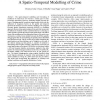Free Online Productivity Tools
i2Speak
i2Symbol
i2OCR
iTex2Img
iWeb2Print
iWeb2Shot
i2Type
iPdf2Split
iPdf2Merge
i2Bopomofo
i2Arabic
i2Style
i2Image
i2PDF
iLatex2Rtf
Sci2ools
108
Voted
WCE
2007
2007
The Dynamic Spatial Disaggregation Approach: A Spatio-Temporal Modelling of Crime
— The spatio-temporal modelling and forecasting of incidences of crimes have now become a routine part of crime prevention operations. However, obtaining reliable forecasts for cases of changing spatial boundaries using models which take the influences of exogenous factors on the spatial and temporal dynamics of crime into account remains a challenge. The proposed Dynamic Spatial Distribution Approach (DSDA) is a modelling approach that provides spatio-temporal forecasts that incorporate the influences of salient weather conditions that have a bearing on crime dynamics at both the temporal and spatial levels. The DSDA starts with modelling and forecasting the dataset of the entire area of interest as a whole. Given reliable forecasts, the DSDA spatially disaggregates them by extrapolating the spatial patterns identified from the historic data. This is carried out by firstly identifying the spatial pattern and then defining a set of weights, one for each of the clusters making up this...
Reliable Forecasts | Spatial | Spatial Pattern | WCE 2007 | WCE 2008 |
Related Content
| Added | 07 Nov 2010 |
| Updated | 07 Nov 2010 |
| Type | Conference |
| Year | 2007 |
| Where | WCE |
| Authors | Christian Ivaha, Hasan Al-Madfai, Gary Higgs, J. Andrew Ware |
Comments (0)

